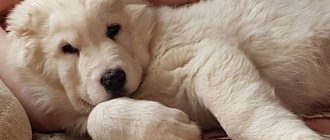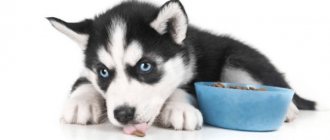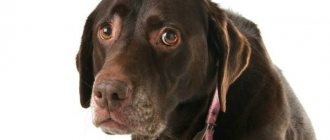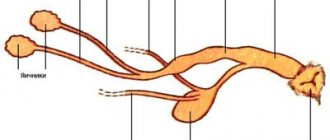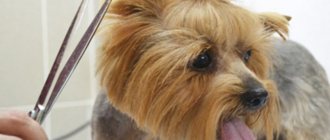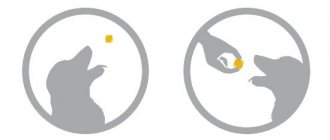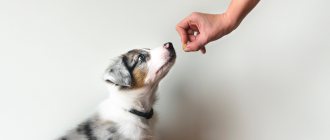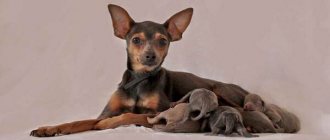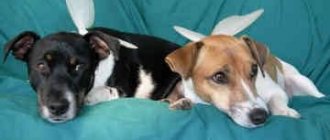Preparing a dog for an exhibition requires a lot of knowledge from the owners of purebred dogs; the requirements for the pet, equipment, and appearance are great; in order to receive an award, a large number of little things must be taken into account. Pay attention to the importance of the psychological aspect for both the four-legged friend and his owner.
General information
The procedure for registering dogs for competitions held by the Russian Cynological Federation is established in the “Regulations”. The document contains the following standards:
- application deadlines;
- required list of documents;
- procedure for paying the registration fee;
- registration of the catalog of exhibition participants of various ranks.
The registration procedure and timing depend on the level of the exhibition. Only accredited organizations can hold competitions. So, at the beginning of the year, when the exhibition plan is being drawn up, cynological organizations can declare their desire to act as an organizer of events at various levels:
- rank CACIB (international (all-breed) exhibition);
- CAC rank (national competition), which determine the following winners:
- RKF champion;
- Federation champion;
- candidate for Federation champion.
In addition, there are exhibitions:
- monobreed;
- all-breed, where representatives of different breeds participate.
At specialty shows, winners are awarded the following titles:
- Club Champion – awarded at annual national exhibitions;
- club winner - interregional exhibitions are held for this purpose;
- candidate for club champion - determined at regional competitions.
Handling
At the exhibition it is necessary to show the dog in a standing position, in motion, and allow the teeth to be examined; to instill in the dog a calm attitude towards the touch and palpation of a stranger’s hands. At the same time, you yourself also practice a lot until it becomes automatic: leading and positioning the dog so as not to block it from the expert, correctly calculating the pace when moving in a group around the ring, etc. Another subtlety is special ones, used only during exhibition training and in the team ring.
The trend now is that cheerful, healthy dogs that meet the breed standard are welcomed at shows.
The start of the display can be indicated by the commands “Work!” or “Ring!” Other handlers use the command "Ring!" to indicate a stance, although the more common sound is “Stand!” or “Show!” To trot around the ring - “Trot!”, “Run!”, “Start!” or “Let’s go!” Everyone is relatively unanimous only when examining teeth: they use the commands “Teeth!” or “Show your teeth!” If someone has already worked with the puppy before you, for example a breeder, use the same commands as he did. If not, find out which commands are used by the handlers who most often work with your breed, or consult with a trainer, but decide on the cherished words before starting classes.
The current trend is that cheerful, healthy dogs that meet the breed standard are welcomed at shows, but without exaggerating certain features, which previously led to veterinary problems (an abundance of skin folds, an excessively short muzzle, etc.). Free, beautiful movements are at a premium; many breeds are now exhibited in a natural stance.
Teaching your baby the basics of showing should include learning to stand and walk correctly on a leash.
Start with one or two five-minute sessions a day. Standing for such a small fidget is not an easy exercise. Choose a moment for training when the puppy is not yet tired, but has already spent excess energy. Classes are carried out on the floor or on a table (for small breeds) with a flat, non-slip surface, if there is a mirror nearby - this will help you control your actions.
When positioned in a handstand, the position of the head, limbs and tail is controlled by your hands. Attention! For each breed, the stance has its own characteristics. Ask the breeder to explain them and show you the correct stance for your puppy. But the sequence of actions is the same for all breeds. They gave the command “Stand!” or “Show!”, put the puppy in a standing position. We praise, repeat the command, gently hold the puppy, distract it by lightly stroking the tummy. We praise and release before the student rebels: 5–10 seconds is also an achievement. We got distracted, gave the student a treat, and repeated it again. That's it, break until tomorrow. We will gradually increase the shutter speed and bring it to 30 seconds.
in a free stance “without hands”. To begin with, the puppy is accustomed to a collar and leash, or to a free ring. Then - to movement at the left leg, so that the student does not pull in different directions, but moves side by side at the pace set by the handler. For this purpose, the puppy is first “running”, then the handler selects a pace that is comfortable for the dog and tries to maintain it. The second stage is to stand up. A well-balanced dog, when stopped correctly from the tempo, immediately moves into the correct position. The main thing in this position is to hold it for some time. For a puppy, this may be a minute, half a minute. The expert understands that there is a puppy in front of him and will not keep him motionless for long.
How to develop this endurance in such small and restless puppies? Each breed has its own subtleties of character, each handler, relying on them, plus the individual character of the pet, develops the most effective techniques. The easiest way is if the puppy responds well to the treat (you should give it in small pieces so that you can lick it off with your tongue, purely for pleasure). Those who react worse to food have to choose another interest, for example, a toy that jumps, or squeaks, or smells, or something else. And for some dogs, praise is enough.
The scheme is simple: the puppy slowed down, ended up in a stand, but then you attracted his attention - he froze for a quarter of a minute, encouraged, praised and moved on.
Where to begin
Anyone can participate in exhibitions with their purebred dog. You can find out the schedule of events on our website, as well as get reliable information from the kennel clubs of your city. They can also help with registration for the exhibition.
But before this, you should undergo a preventive examination by a veterinarian and vaccination. A veterinary passport, and in some cases a veterinary certificate, will be required directly at the exhibition, but you need to make sure your pet is in excellent health and get the necessary vaccinations in advance.
Comprehensive vaccination and rabies vaccination are mandatory: it is valid for 1 year, and the vaccination should be given no later than a month before the planned exhibition. Veterinary control is especially strict about animals coming to competitions from other regions. To travel outside your region, you should obtain veterinary certificate No. 1 from your doctor the day before.
We teach you to touch and show your teeth
At the show, experts will definitely touch and feel the puppy. Teach your child to treat this correctly. It is not difficult to teach your pet to be touched and the dog likes it. The main thing is not to allow biting of the palms as part of a fun game.
To prevent the experts' touch from making your puppy nervous, ask someone to act as a judge at a dog show. Let one of your family members or friends perform the manipulations under your guidance. Movements must be careful, smooth, and force must not be used. Praise your child for his patience.
Experts at the show will touch the puppy to make it show its teeth. Teach your baby in advance - teach the “Teeth” command. After giving the command, gently expose the dog’s jaws with your hands. The puppy will show dissatisfaction, your task is to calm it down, and after the procedure, praise it and give it a treat. Practice the exercise regularly until the puppy gets used to it. Do not forcefully expose your teeth, causing pain to your dog!
It is advisable to accustom the baby to touching and examining the table, imitating an exhibition.
Dog registration procedure
You need to register for the exhibition in advance: as a rule, 10-14 days before the event, registration ends for the CAC rank; registration for the CACIB rank exhibition ends even earlier - 30 days before the event. When finding out when and where the exhibition will take place, it is better to immediately clarify the list of required documents and select the class in which the pet will be registered.
Important!
After registration, transfer to another class is not permitted.
Each organizer has its own registration rules and requirements for submitting documents. However, there are also general provisions. So, in addition to filling out the application, the owner submits:
- a copy of the pedigree (puppy card - puppies under 15 months);
- a copy of the document confirming payment of the organizational fee for participation in the exhibition.
The payment procedure and the amount of the registration fee are established by the organizers of the event, who must:
- be registered as a legal entity;
- have an open bank account;
- timely transfer payment for the event to the RKF bank account.
Application form
An application for a pet to participate in an exhibition is made by its owner. It must indicate:
- breed and name of the dog, show class;
- Date of Birth;
- gender and color;
- pedigree data;
- stamp data;
- nicknames of the parents of the dog participating in the exhibition;
- details of the breeder and owner of the animal (indicating home address, contact telephone number).
All data is filled in by the applicant independently. By signing the application form, the owner is responsible for everything contained in it.
Important!
Registration for some exhibitions is possible online. You should check with the event organizers about this possibility.
Pedigree
Only purebred animals are allowed to compete. In addition, the RKF without restrictions recognizes the pedigrees of member countries of the FCI (Federation Cynologique Internationale), as well as the American, Canadian and English Kennel Clubs. Animals with the export pedigree “Export Pedigree” are allowed to participate in international exhibitions of the CACIB rank.
Important!
When planning to participate in major international dog shows and foreign competitions, you should obtain a breeding certificate (export pedigree) of the established form in advance. Issues an RKF document instead of a regular pedigree.
Selecting an exhibition class
According to the general rules, all registered animals can compete in one of the following classes:
- Baby (for puppies from 3 to 6 months);
- Puppy (6-9 months);
- Junior – from 9 to 18 months;
- Open (open class).
In addition, there is a Working class for service and sporting animals. If a dog already has titles and awards, it can participate in competitions in the Champion class. For animals over 8 years old, the Veteran class is provided.
Important!
To enroll in the worker and champion classes, you must provide supporting certificates issued by the FCI or RKF.
Not all shows involve puppies younger than six months of age. The organizers decide on the participation of Baby class puppies in competitions independently. The age of the animals is determined on the day preceding the exhibition. In case of discrepancy between the data specified in the pedigree and the entry form, the dog may be removed from the competition.
In the event of the death of an animal during the period between submitting an application for participation and the exhibition, the owner is obliged to inform the organizer of the event about this, attaching the original certificate issued by the veterinary clinic. If registration for the exhibition has not yet been completed, the owner will be refunded the amount of the registration fee paid.
Veterinary documents
Having a veterinary passport with notes on mandatory rabies vaccination is another important condition for every four-legged participant in the competition. In some cases, exhibition organizers require a veterinary certificate about the health of the animal.
The need for it must be clarified in advance, since veterinary control employees on the day of the competition have the right to not allow the participant to enter the ring. The organizers do not bear any responsibility if the dog is disqualified.
Disqualification
Except in cases where a dog was removed from the competition due to lack of veterinary documents, the organizers have the right not to allow it to participate in the exhibition if the animal was previously disqualified.
Judges can disqualify a dog for its appearance or behavior uncharacteristic of the breed. Organizers are required to report the reason for awarding the white ribbon to the RKF. The Federation publishes the protocol on the website. The organizers are responsible for the admission of a disqualified dog to further exhibitions.
Exhibition condition
In my opinion, a puppy should be a little more well-fed than an adult dog. But when raising large dogs today, they try to avoid excess weight so that there is no unnecessary stress on the ligaments and joints. Each breed has its own age-specific “ideal” of fatness, and an expert who is well versed in its characteristics can correctly assess a puppy’s condition. You are required to provide your pet with adequate nutrition and physical exercise so that the puppy develops according to age and breed criteria. To the traditional question of which food is better, I will answer: the one on which the puppy grows well and feels great.
Problems begin when the dog’s diet suddenly changes dramatically.
Many of my dogs eat PEDIGREE® all their lives: they start with the first food, then move on to puppy food, then to adult dog food. The food has been on our market for a long time, is always available in stores, and can be safely recommended to those who have purchased a puppy from you. And if we take the financial aspect, a large number of families can afford to raise a dog on this particular line of food. PEDIGREE® provides excellent condition and I am very happy with the price/quality ratio.
Problems begin when the dog’s diet suddenly changes dramatically. Individual characteristics really exist. Objectively, more expensive food should have premium qualities, but subjectively the body may not appreciate this and give an undesirable reaction to some tertiary component. Feed the puppy what he is accustomed to from the breeder. Moreover, do not change food suddenly on the eve of the exhibition.
Exhibition - certificate
At exhibitions of different ranks, certain certificates are issued. It is advisable to understand them before participating.
| Black Sea Fleet | CHRKF | CACIB | |||||||
| BOS (best male, female) | CW (class winner) | JBOB (junior class winner) | BOS (best male, female) | CW (winner class) | JBOB (junior class winner) | BOS (best male, female) | CW (class winner) | JBOB (junior class winner) | |
| CAC | + | + | + | + | |||||
| Black Sea Fleet | + | + | + | ||||||
| CHRKF | + | + | |||||||
| JCAC | + | + | + | ||||||
| YuChF | + | + | |||||||
| YuChRKF | + | + | |||||||
Who will help
Only a specially trained specialist handler can best demonstrate a dog’s potential. He perfectly masters the art of showing dogs.
The services of this specialist are necessary not only on day X, but also at the preparatory stage. The handler will create a training schedule with clear times and days off, which will allow you to prepare well. All that is required from the owner is compliance with the lesson schedule.
You also cannot do without the services of a groomer who can prepare the pet’s appearance in accordance with the standards of this breed.
Attention! The involvement of a handler and groomer is not mandatory, but they can significantly increase the pet’s assessment with little experience of the owner.
Exterior rating system
One of the main criteria for evaluating a dog is its exterior. The peculiarity of the appearance of an animal characterizes its performance, state of health, age, strength and other qualities.
At exhibitions, when judging, private and general exteriors are taken into account. The first shows the conformity of the animal's makeup to the standard of a certain breed. In accordance with this indicator, the degree of thoroughbred of the dog is determined: high-breed, pedigree, typical and simple. The general exterior allows you to evaluate the animal without reference to its breed.
Attention! Correct assessment of the exterior is only possible with knowledge of the dog's anatomy. The judges are serious specialists.
Exterior assessment
What and how is evaluated at exhibitions
The assessment is carried out by an expert. After examining each dog, he makes a description and gives a rating. Only animals with an excellent score are allowed to compete.
In accordance with the mark received, participants receive a ribbon of the corresponding color:
- Red (excellent).
- Blue (very good).
- Green (good).
- Yellow (satisfactory).
- White (disqualification).
In some cases, show dogs do not receive a grade. Then they are disqualified and they do not take part in the competition.
Correct movements
From the second lesson , the handler begins to teach the puppy how to move correctly
. In the ring, the dog should run at a beautiful sweeping trot. Not every puppy will want to walk on a narrow, thin rope the first time (for a puppy this is a rope, but for us a show leash is a show leash), but with the right approach this should not bother him and a good handler will quickly teach the puppy to walk on a show leash. To begin with, the handler simply walks, gradually increasing the pace. You can move on to a beautiful, correct trot around the third lesson. You should not overload the puppy so as not to harm its anatomical development.
